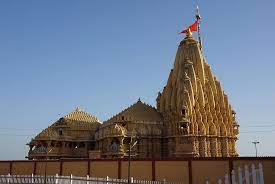
Nestled on the western coast of India, overlooking the Arabian Sea, stands the illustrious Somnath Temple, a sanctuary that breathes life into the ancient tapestry of Indian spirituality. With a history dating back over a millennium, this sacred edifice has withstood the test of time, bearing witness to the ebb and flow of civilizations, invasions, and reconstructions.
The Somnath Temple, dedicated to Lord Shiva, stands not just as an architectural marvel but as a symbol of unwavering faith and cultural resilience.
Historical Tapestry
The history of Somnath Temple is as rich and diverse as the nation it represents. Legend has it that the original temple was built by none other than Lord Soma, the Moon God, in gold. Over the centuries, the temple underwent several renovations, each narrating a unique chapter in its history. The famed temple finds mention in ancient texts such as the Skanda Purana, where it is revered as “the first place of pilgrimage.”
The temple faced its first documented invasion in the 11th century when Mahmud of Ghazni, a Central Asian ruler, raided the temple, looting its treasures and leaving destruction in his wake. This event marked the beginning of a series of invasions and reconstructions that would characterize the temple’s narrative.
Resilience and Reconstruction
Despite facing numerous invasions, the spirit of Somnath Temple remained unbroken. Each time it was desecrated, it rose from the ruins, reflecting the indomitable spirit of the Indian people. The temple was reconstructed several times, with notable efforts during the reigns of Chaulukya, Chalukya, and Solanki rulers. The most significant reconstruction, however, took place under the patronage of Raja Bhoja of Malwa and King Bhimdev of Gujarat in the 11th century.
The Solanki dynasty’s reign witnessed the construction of a magnificent temple adorned with intricate carvings and sculptures, showcasing the zenith of Indian art and architecture during that era. The temple complex also featured an imposing shikhara (spire) that soared into the sky, symbolizing the spiritual aspirations of the devotees.
Somnath Through the Ages
The temple continued to be a symbol of devotion and cultural identity, attracting pilgrims from far and wide. The renowned Arab traveler Al-Biruni, who visited India during the 11th century, documented the grandeur of Somnath in his writings, describing it as a place of unparalleled sanctity.
However, the centuries that followed were marked by tumultuous times, including the Mughal era, where the temple faced repeated invasions and reconstructions. Yet, with each adversity, Somnath Temple emerged stronger, a testament to the resilience ingrained in its sacred stones.
Modern Era and Restoration
The 19th century witnessed yet another chapter in the saga of Somnath Temple. The temple faced neglect and dilapidation under various rulers. However, the turning point came in the 20th century when efforts to restore and revive the temple gained momentum.
Sardar Vallabhbhai Patel, the Iron Man of India and a key figure in the country’s independence movement, played a pivotal role in the restoration of Somnath. In 1951, Patel, along with then President Dr. Rajendra Prasad, initiated the restoration project, symbolizing the unity and resilience of the newly independent India.
The present structure, inaugurated in 1951, reflects a harmonious blend of modern architecture and ancient aesthetics. The temple complex boasts intricate carvings, captivating sculptures, and a serene ambiance that draws millions of pilgrims and tourists annually.
Cultural Significance
Somnath Temple transcends its role as a mere religious monument; it stands as a living embodiment of India’s cultural and spiritual heritage. The temple’s significance extends beyond religious boundaries, embodying the syncretic ethos that defines the Indian subcontinent. Pilgrims from various faiths and backgrounds converge at Somnath, united by a shared reverence for its timeless sanctity.
The Aarti performed at the temple, accompanied by the rhythmic chanting of sacred verses, creates an atmosphere charged with spiritual energy. The sound of the temple bells resonates with the heartbeat of devotion, echoing across the ages.
Conclusion
Somnath Temple, with its storied past and enduring resilience, stands as a symbol of India’s spiritual fortitude. Its journey through time reflects the ebb and flow of history, a testament to the cultural mosaic that defines the nation. In the face of invasions, destruction, and neglect, the temple has risen, phoenix-like, to remind the world of the indomitable spirit of its people.
Today, as pilgrims and visitors flock to Somnath, they become part of a timeless pilgrimage, connecting with the divine and experiencing the living history etched in the sacred stones of this extraordinary temple.
